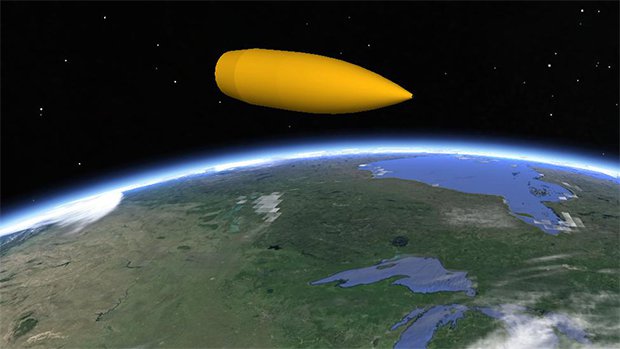Following the long range shooting series? Here’s the next installment of external ballistics theory: the Coriolis Effect. On Bullet Trajectory Part 1 and part 2, I talked about Coriolis Effect as a variable which affect the bullet flight both on the horizontal and the vertical plane of the trajectory. But what exactly is Coriolis Effect?
When talking about ballistics, the Coriolis Effect refers to the deflection on the trajectory of the bullet generated by the spinning motion of the Earth. Its effect is negligible at medium distances, but becomes important around 1000yds and beyond, especially because it can add to other minimal errors and keep you off target.
Coriolis effect affects everything not firmly attached to the Earth’s surface. It affects fluids, like air and water, as well as floating and flying objects like ships, airplanes and… bullets.
Despite being associated with Coriolis, the phenomenon that actually affects the vertical component of the trajectory is called Eötvös Effect. The rotation of the Earth generates a centrifugal force, the same that pushes you to the side when you make a sharp turn with your car. This force acts perpendicular to the Earth rotatory axis, adding or subtracting to the gravity force. When an object flies eastward, in the same direction of Earth’s rotation, centrifugal force acts opposite of gravity, pushing it away from the Earth’s surface. If the object flies westward, in the opposite direction of the Earth rotation, centrifugal force pushes the object toward the ground concurrently to gravity force. Thus, bullets fired to the east always fly a little higher, and, conversely, bullets fired to the west always travel somewhat low.
The amount of drop change is in function of:
Latitude – The linear velocity of a point on the Earth’s surface, and thus the amount of centrifugal force, is maximum at the equator and decreases going toward the poles, where it is null.
Shooting direction, or azimuth – The amount of drop change is highest when shooting east or west, and as the trajectory angles northor south, the amount of drop change decreases, becoming null, as the angle points toward either pole.
Muzzle velocity – The amount of centrifugal force is determined by the speed of the flying object.
Before, I mentioned that the vertical element associated with the Coriolis effect is actually called the Eötvös effect. To give you an idea how the Eötvös effect alters a trajectory, here’s an example. Let’s say you’re firing a .308 175gr bullet, with a muzzle velocity of 2700fps, from a latitude of 45°. The drop at 1000yds will be 392 inches, shooting either to the north or south (without error). Shooting with an azimuth of 90°, or eastward, the drop will be 388in. Shooting with an azimuth of 270°, or westward, the drop will be 396in. In either case, there is a total change in drop of 4in. An easy assumption is to predict that, when shooting with an intermediate azimuth, that the drop change will be linear. This is incorrect. Instead of a 2in change for an azimuth of 45°, the error is a function of the sine of the azimuth angle. For those of you who don’t have a fondness for trigonometry, this essentially means that you have half the error at 30° rather than at 45°. Changes in latitude have a minimal effect, since at the equator, where the effect is greatest, the error would be 5in, only one inch more than the error we calculated at 45° latitude.
What is most affected by Coriolis Effect is the horizontal component of the bullet trajectory. Because of the Coriolis effect, every moving object not connected to the ground is always deflected to right in the Northern Hemisphere, and always toward left in the Southern Hemisphere. The deflection is not east or west, but specifically to the right or left with reference to the shooting direction. It doesn’t matter in which direction you shoot; it is a function of latitude and average bullet speed. Its effect is maximum at the poles, and decreases as one moves toward the Equator, where it is minimal. The explanation of this phenomenon is more difficult than the explanation of Eötvös Effect, so I won’t go into it into detail.
Here’s an expample of error due to Coriolis effect: firing the same .308 175gr bullet at 2700fps muzzle velocity, from a latitude of 45° in the Northern Hemisphere, the deflection at 1000yds will be of 3in to right. At the North Pole, where the effect is maximum, the deflection will be a little more than four inches. The deflection will be the same in the Southern Hemisphere, but it will be to the left, instead.
Already have an account? Sign In
Two ways to continue to read this article.
Subscribe
$1.99
every 4 weeks
- Unlimited access to all articles
- Support independent journalism
- Ad-free reading experience
Subscribe Now
Recurring Monthly. Cancel Anytime.
As you can see, these errors are subtle, even when shooting long distance.However, especially when combined with other potential error factors in your long distance shooting equation, it could make the difference between hitting and missing your target. If you have portable ballistic software, you can use it to calculate Coriolis for you at every distance. But, if you’re doing the math on your own, I wouldn’t start to take Coriolis into consideration unless shooting at 1,000 yards, or more.
The Coriolis effect is more complicated than movies like Shooter make it seem, isn’t it?
This article is courtesy of Alessio Baldi from The Arms Guide.









